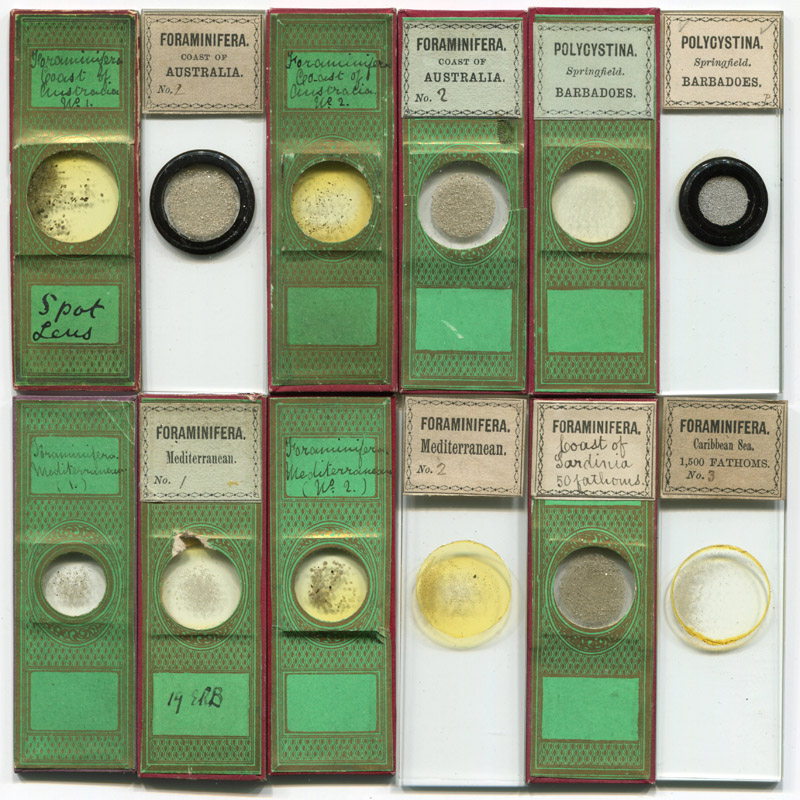
Figure 1. Examples of four papering and labeling combinations used by Greenpapers.
Unidentified Slide-maker “Greenpapers”
circa 1860 onward
by Brian Stevenson
last updated July, 2025
The name of these slides’ maker is not known. The histories, specimens, manufacturing styles and secondary labels on the microscope slides illustrated below indicate that they were made in England from the early 1860s through at least the 1880s. Slides with this maker’s handwriting are highly abundant today, suggesting that this person was a significant producer of microscope slides. Duplicates are frequently seen, indicating that the maker was probably a professional. Secondary labels from large London microscopy dealers support that conclusion, and suggest a base of operation in the English capital city. There is evidence that Greenpapers associated to some extent with major names in Victorian English natural history, including Thomas Huxley, which is described below after Figure 6.
Any ideas on who might have made these high quality slides will be greatly appreciated. Please send emails to brian.stevenson@uky.edu
The vast majority of this mounter’s slides have a generic-patterned gold-on-green top paper, giving him (her?) the nickname “Green Papers” among collectors. Very rarely, red cover papers are encountered (Figure 4).
Examples of four variant labeling types are shown in Figure 1. Many of Greenpapers’ slides have handwritten specimen descriptions. Many of those same descriptions, on slides with the same green paper, are also seen on type-set labels. While the labels loosely resemble those used by R & J Beck, the borders are distinct and, most importantly, the Beck name is absent. While it is possible that Beck and Greenpapers used the same printer, there are no reasons to assume that they were professionally connected. An intermediate form of label is occasionally encountered, in which the specimen description is hand-written onto a printed label. In addition, Greenpapers’ type-set labels are often found on unpapered slides. The same subject matter is often found on slides of multiple types. Based upon the fashion trends of Victorian slide-making, Greenpapers’ preparations probably progressed from papered slides with handwritten descriptions, to papered slides with type-set labels, and then to unpapered slides with type-set labels.
Greenpapers made slides of a wide variety of specimens:
A major focus appears to have been ocean soundings from throughout the world, many of which can be traced to exploratory cruises from the 1860s and 1870s, and are generally labeled as “Foraminifera”, along with the site of origin.
A second major focus was segments of insects and spiders. Series appear to have been issued, with dissected pieces of insects, such as the blowfly, running upwards of 12 different slides. Curiously, however, this maker does not appear to have made any slides of entire insects.
Other Greenpapers slides run the common gamut of botanicals, sea life, and some diatoms and minerals.

Figure 1.
Examples of four papering and labeling combinations used by Greenpapers.
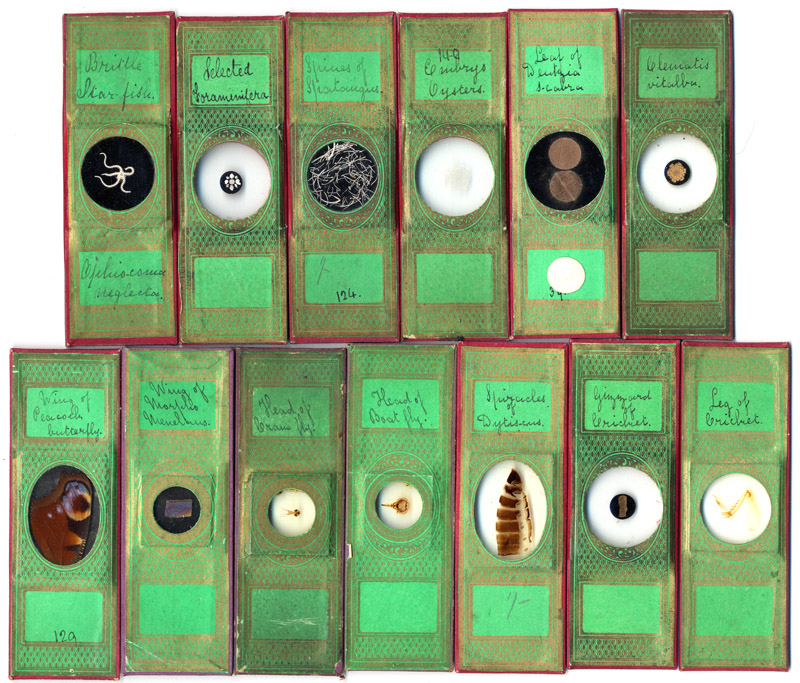
Figure 2. An assortment of microscope slides by this unknown mounter. A wide range of specimens were mounted, ranging from insect parts to sea life to botanical tissues. He almost always used off-the-shelf green papers on the fronts of slides. Sides and edges are generally covered with plain red paper, although purple is not uncommon. Specimen mounting and slide papering are consistently clean and neat.

Figure 3. Although Greenpapers is not known to have produced slides of whole insects, this maker did produce many slides containing insect parts. Illustrated here are eight slides of various parts of the blow fly.

Figure 4. Two slides by this maker, of the same subject, using the common green and very rare red paper covers.
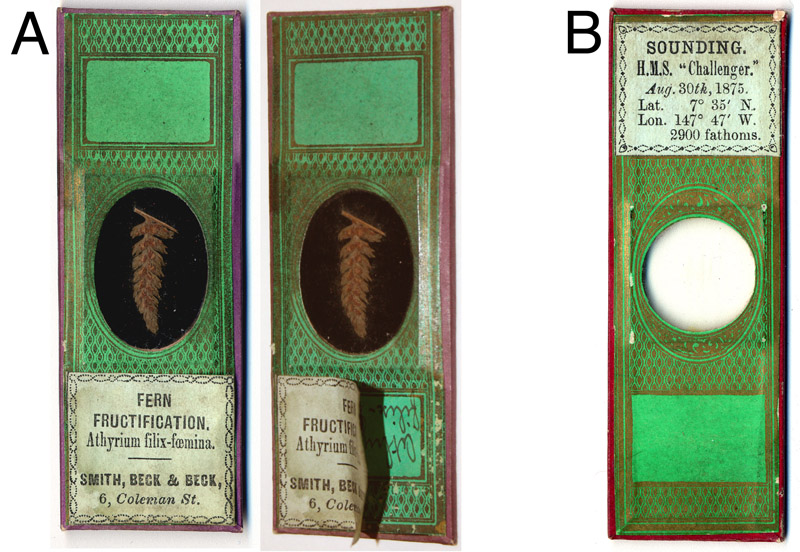
Figure 5. Some indications of the dates of Greenpapers’ operation. (A) A slide by the maker, with labels from Smith, Beck and Beck. Greenpapers’ handwriting is underneath the SBB label. Smith, Beck and Beck moved from 6 Coleman to 31 Cornhill in the middle of 1863, indicating that Greenpapers was producing slides before that time. (B) The H.M.S. Challenger returned to England in 1876, indicating that Greenpapers was producing microscope slide beyond that time.
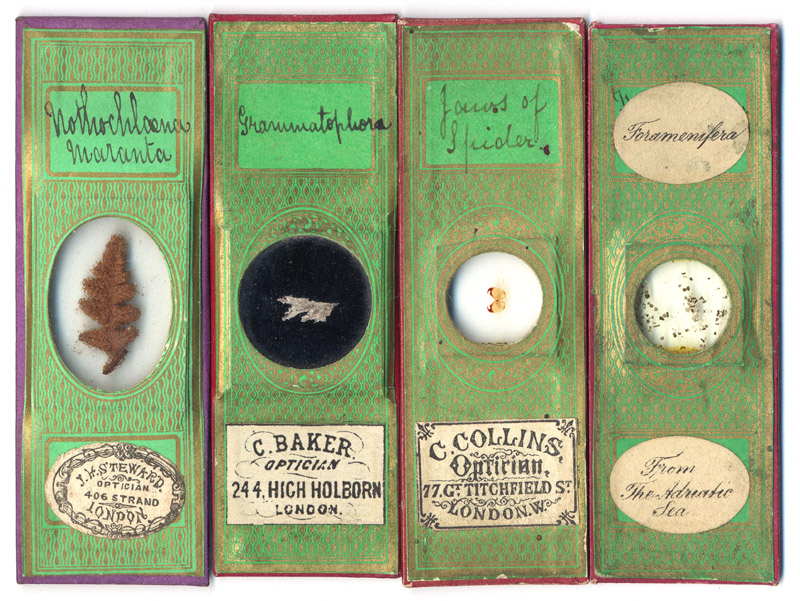
Figure 6. Four slides by this maker that were retailed by major London microscope supply houses: Steward, Baker, Collins and Wheeler/Watson. The rightmost slide, of foraminifera from the Adriatic Sea, has labels from Wheeler or Watson applied over the maker’s handwritten description.
A type of microscope slide is occasionally seen, with papering and finish like Greenpapers’, but with small type-set descriptive labels and a number (Figure 7A). Two variants are known, "Ooze from Atlantic Bed, 2,000 fathoms" (with a number 9), and "Grains of chalk prepared for microscope" (with a number 11). The descriptions and numbers correspond with specimens sold to aid students of Archibald Geikie’s Geology, from 1874 until at least 1910 (Figure 8). The description of slide number 9 corresponds with one of Greenpapers’ common preparations, and a Greenpapers slide is known that bears an additional label with the number 9 (Figure 7B, rightmost slide).
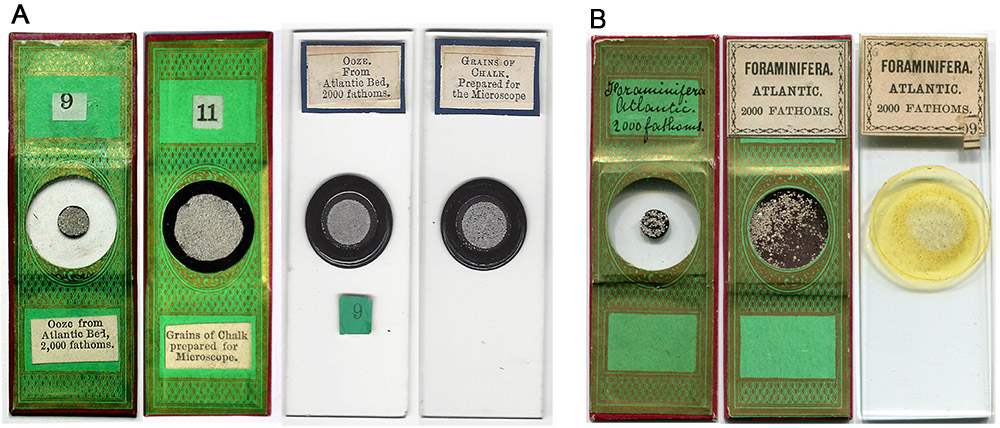
Figure 7.
(A) Microscope slides associated with Archibald Geikie’s "Geology".
(B) Three slides by Greenpapers, of the same material as the number 9 slide in panel A. Note that the rightmost slide carries an additional label with the number "9".
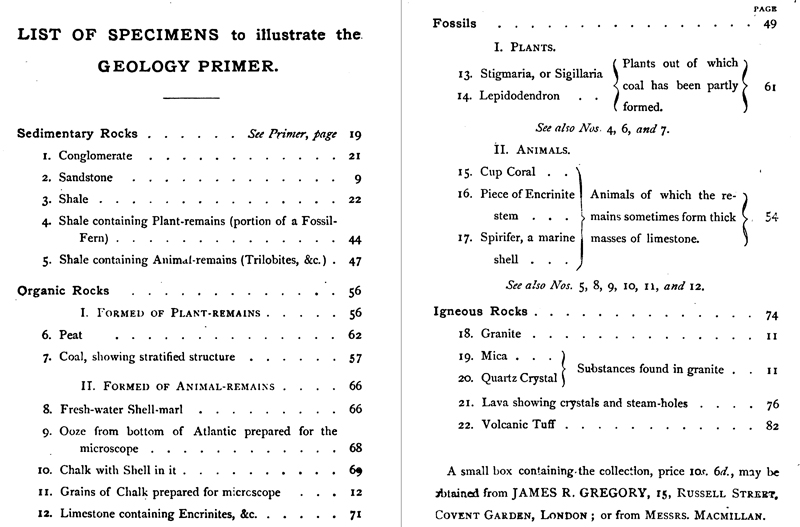
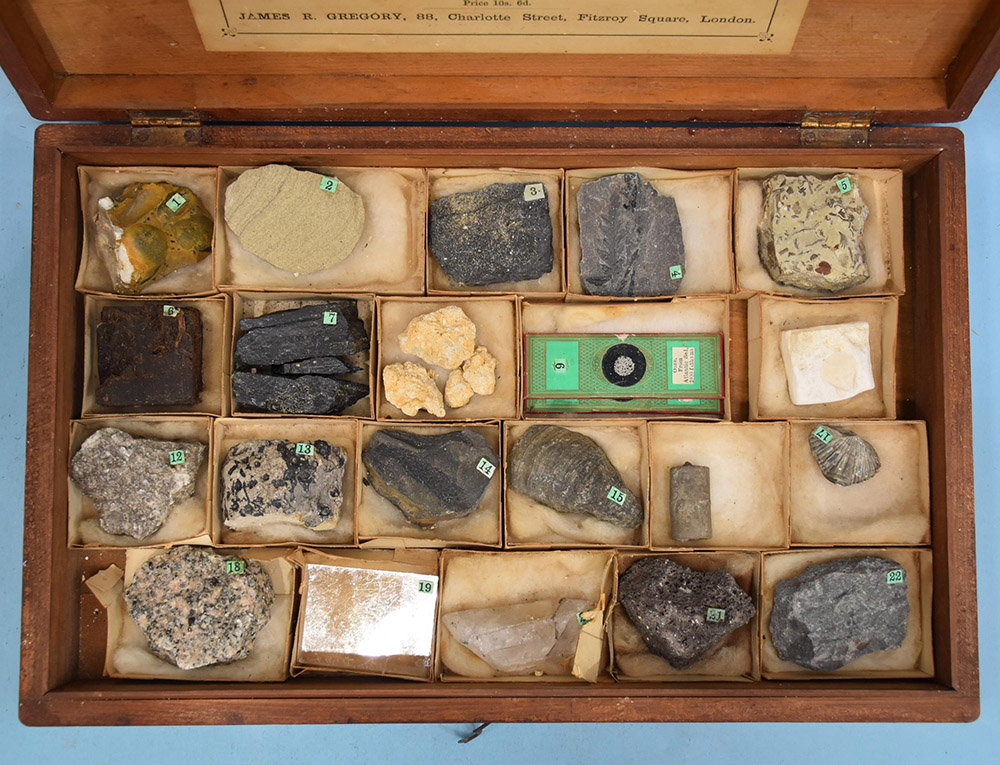
Figure 9.
A case of geological specimens that includes Greenpapers' slides 9 and 11, sold by James Gregory, London. Adapted for nonprofit, educational purposes from an internet auction site.
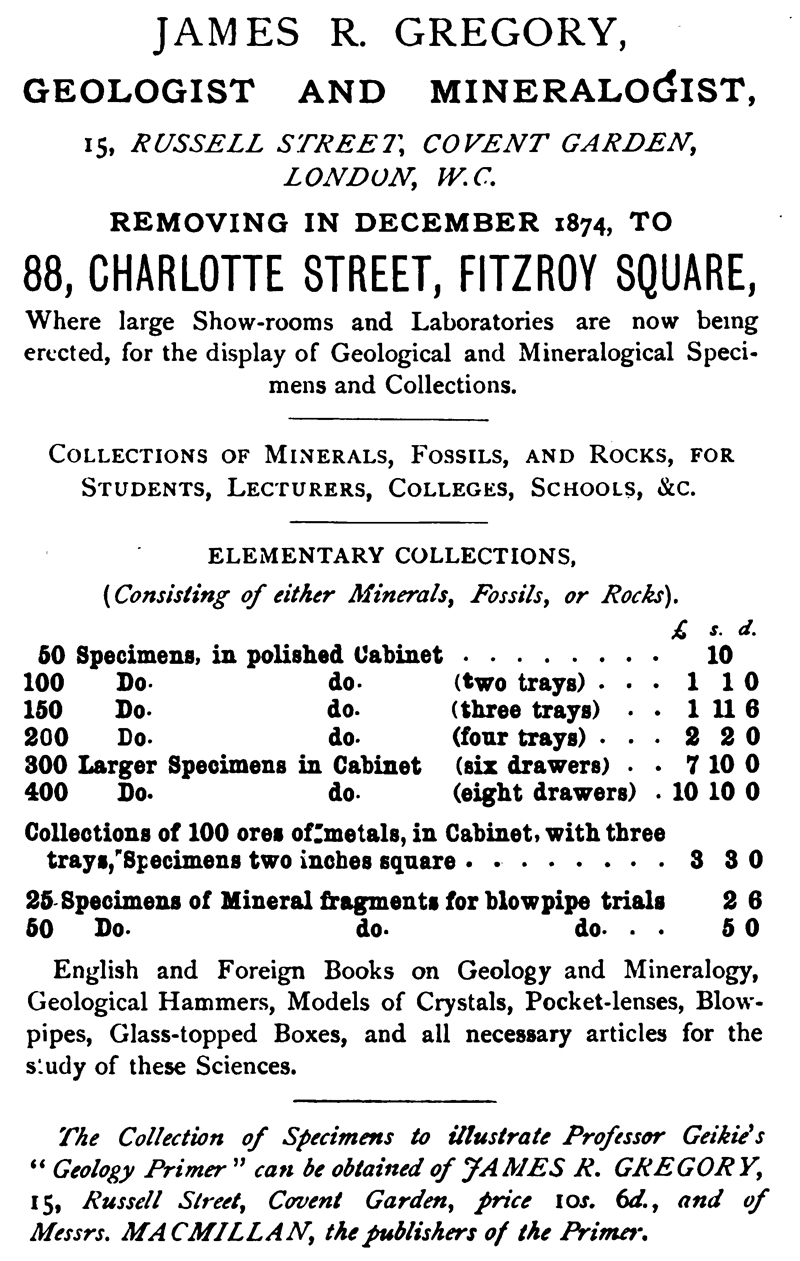
Figure 9.
Two pages from the rear of the 1874 edition of Geikie’s "Geology", listing 22 specimens for sale from the London shop of James Gregory or through the publishers. Specimens 9 and 11 correspond with the microscope slides illustrated above in Figure 7A.
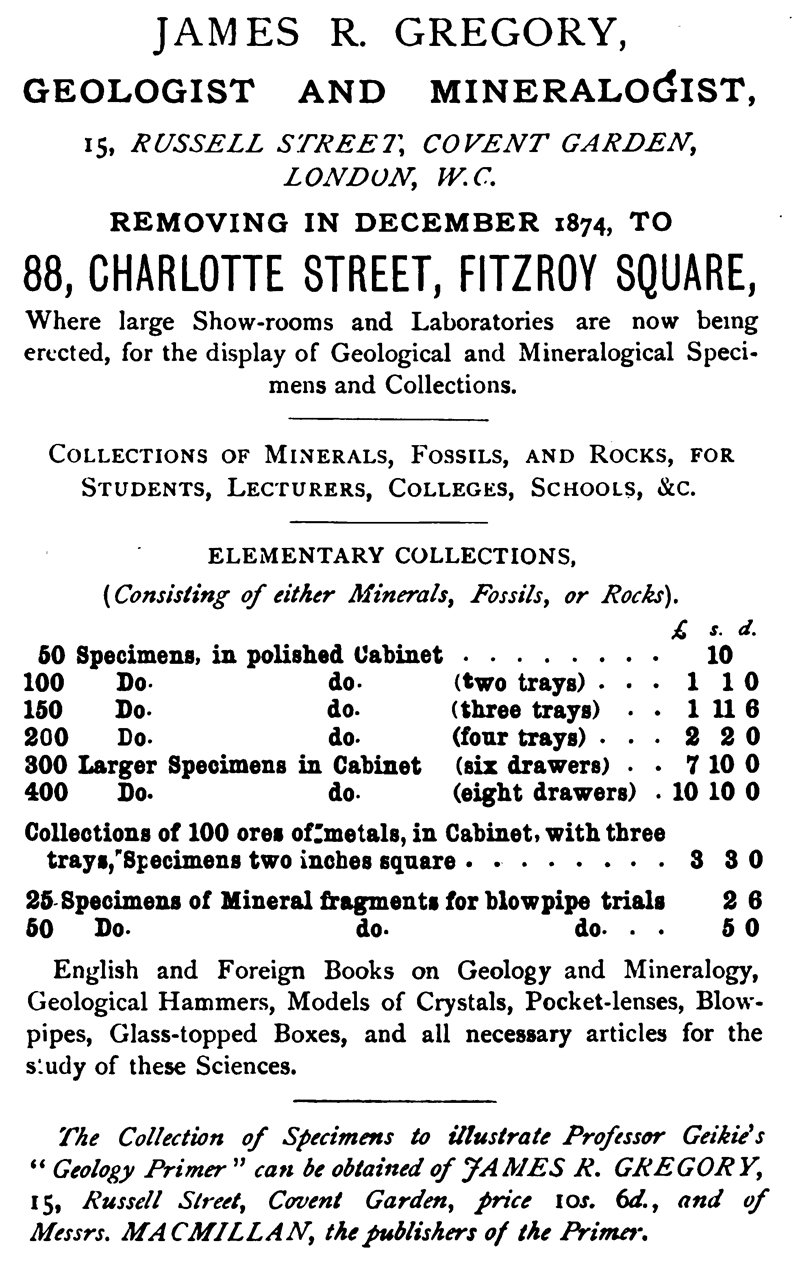
Figure 10.
An advertisement by James Gregory, from the rear of the 1874 edition of Geikie’s "Geology". Gregory was a geologist, with no known interest in any of the other objects that were mounted by Greenpapers, such as botany or entomology.
Geikie was a university professor of geology, and so was unlikely to have also been a professional maker of plant or insect slides. The back of Geikie’s book states that specimens, including two specimens for the microscope, can be obtained from the shop of James Gregory or the publishers, Macmillan and Company, both of whom were located in London (Figures 8 and 9). This supports the hypothesis that Greenpapers was also based in London. Gregory specialized in geological specimens, with no known connections to entomology or botany, and so was probably not Greenpapers. The editors who organized Geikie’s book, and several other similar ’primers’, were Thomas Huxley, Henry Roscoe, and Balfour Stewart. Stewart was a physicist, and Roscoe was a chemist. Huxley was then Professor of Natural History at the Royal School of Mines and, among other things, member of the Quekett Microscopical Club (its president from 1877-1879). Of all the people affiliated with Geikie’s book, Huxley was the most likely to have close associations with a professional microscope slide maker who also mounted non-geological objects. Although it is not particularly likely that Greenpapers was Huxley, I feel that these slides give good reason to suspect that Greenpapers was an associate of Thomas Huxley.
Resources
Geikie, Archibald (1874) Science Primers: Geology, second edition, edited by Thomas Huxley, Henry Roscoe, and Balfour Stewart, published by Macmillan and Co., London
Geikie, Archibald (1900) Elementary Lessons in Physical Geography, published by Macmillan and Co., London. The rear of the book includes an advertisement for Primer of Geology, which states that a "Box of geological specimens to illustrate Geikie’s Primer Of Geology" was available for 10s. 6d.
Geikie, Archibald (1910) The Teaching of Geography, third edition, published by Macmillan and Co., London. The rear of the book includes an advertisement for Primer of Geology, which states that a "Box of geological specimens to illustrate Geikie’s Primer Of Geology" was available for 10s. 6d.